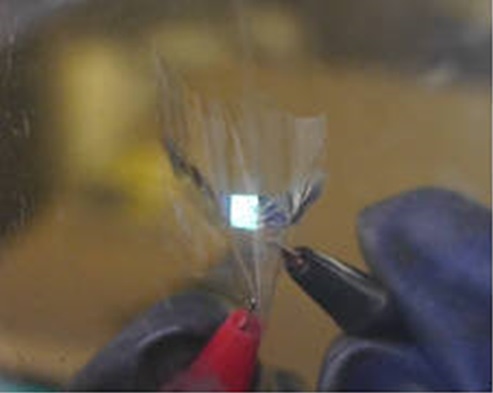Curve Radius of 0.03㎜…OLED Electrode Material Developed
An Organic Light Emitting Diode(OLED) electrode material with a curve radius of merely 0.03㎜ has been developed. It is one hundredth the size of previous materials. Smartphones of which the display can be folded in half like paper have now become possible.
Korea Electronics Technology Institute(KETI) announced on April 9th that they developed the world’s highest ultra high flexion transparent electrode with a maximum curve radius of which can be folded thinner than a strand of hair(approximately 0.1㎜).
They fused silver nano wire(AgNW) with colorless polyimide. The maximum curve radius previously developed was 5㎜. For reference, the curve radius when folding a sheet of paper is 1㎜.
Experimenting with this material, the prerequisite number of repetition of bending for applying to a foldable product was 100 thousand times.

Assuming that one folds and unfolds a smartphone 100 times a day, there will be no problem for two years(73 thousand times). For a tablet PC, of which the number of folding times drops to only dozens, there will be no problems in using it for years.
The transparent electrode also gives high performance. Transmission of visible light reached 90%, and sheet resistance reached 8 ohm/sq. Surface roughness is 0.8 ㎚, similar to the glass substrate used in smartphones.
The criteria of the industry for foldable material is a radius of curvature of 1㎜, curve repetition of 50 thousand times, sheet resistance of 15 ohm, transmission of 85%, and surface roughness of 1㎚.
The transparent electrode material was discovered during the improvement process of silver nano wire flatness. While adjusting surface roughness by plasma processing in the polymer substrate, an element with the efficiency equivalent to that of OLED was discovered.
Kim, Jong-woong, doctor of Korea Electronics Technology Institute Display Component Material Research Center said, “We developed an ultra high flexion transparent electrode during our search for a optimal combination for maximizing the performance of nano material.”
KETI is proceeding the development of a processing technology for components research and mass production applicable to the next generation smart products.
Han, Cheol-jong, executive director of KETI Display Fusion Research Center said, “The transparent electrode will become the core material in increasing the degree of freedom in designing IV devices such as foldable smartphones. We will strive to develop remaining components to lead the Foldable Age.”
Senior Reporter Kim, Joonbae | joon@etnews.com